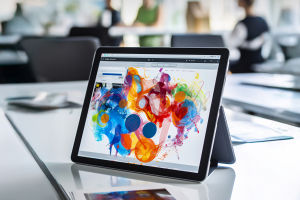Filmmaking has always been a creative process, but technological advances continually redefine what is possible on screen. One such advancement that has been making waves in recent years is virtual production.
A perfect example of this is LED virtual studios, used in groundbreaking shows like The Mandalorian.
This technology, combined with real-time rendering, is changing the way we think about film sets and the shooting process itself. In this article, we will explore how virtual production is reshaping the film industry and what it means for filmmakers in the future.
What is Virtual Production?
Virtual production involves the integration of physical and digital elements in real time, enabling filmmakers to create realistic virtual environments on set while shooting scenes. Traditional filmmaking required creating elaborate physical sets or relying on post-production to add digital environments. However, with virtual production, filmmakers can now create entire worlds using LED screens and real-time rendering technology, effectively blurring the lines between what's real and what's virtual.
The Technology Behind Virtual Production
At the heart of virtual production are two primary technologies: LED screens and real-time rendering.
• LED Screens: These large, curved screens act as the backdrop for virtual environments. The benefit of using LED screens over traditional green screens is that the lighting and reflections are real and can be interacted with by the actors and objects on set. The reflective surfaces and dynamic lighting of these screens blend seamlessly with physical elements, creating a more natural and immersive environment.
• Real-time Rendering: This process refers to generating images and environments on the fly while shooting. Unlike traditional CGI, which is processed after filming, real-time rendering allows filmmakers to see the final output immediately. This allows them to make adjustments to lighting, camera angles, and even environmental details without needing to wait for the post-production process.
Together, these technologies create an incredibly powerful tool for filmmakers, allowing them to make quick decisions and experiment with different elements while filming.
The Impact on Filmmaking Process
One of the key advantages of LED virtual studios and real-time rendering is the reduction of time and cost associated with traditional filmmaking. By eliminating the need for elaborate set constructions or travel to far-off locations, filmmakers can create a wide range of environments from within the studio. This leads to faster shooting times and reduced production costs.
Additionally, the flexibility of virtual production allows for greater creative freedom. Filmmakers can adjust the environment in real time, creating endless possibilities for storytelling. For example, if a director wants to change the color of a sunset or adjust the texture of a cityscape, these elements can be modified instantly, making the creative process more fluid.
Another notable benefit is the environmental impact. Traditional filmmaking often involves the transportation of large crews and materials to remote locations, leaving a significant carbon footprint. With virtual production, much of the environmental work can be done on the studio lot, leading to more sustainable filmmaking practices.
Real-time Rendering: Changing the Game
Real-time rendering is where the magic truly happens. This technology enables filmmakers to make immediate adjustments to virtual environments, characters, and scenes. It allows for a more dynamic and collaborative filmmaking process, as the director, actors, and other members of the team can see the visual results while still on set.
This method eliminates the need for post-production visual effects to create the final look of the film. Instead, filmmakers can interact with the virtual environment in real time and adjust details on the spot. It's a revolutionary change from the traditional process where visual effects are added after filming, sometimes months later.
Moreover, real-time rendering allows for more realistic lighting and shadow effects, which are crucial for immersing the audience in the scene. The actors can see the environment they're interacting with, making their performance more authentic and grounded in the world they are portraying.
Challenges and the Future of Virtual Production
While virtual production brings a wealth of benefits, it does come with its own set of challenges. For one, the technology requires a significant investment in hardware and software. Virtual studios need powerful computers to handle real-time rendering, and the setup of LED screens can be costly. However, as technology advances, the cost of these tools is expected to decrease, making virtual production more accessible to a wider range of filmmakers.
Additionally, the skill set required to operate these advanced technologies is still relatively new. Filmmakers, VFX artists, and technicians must be trained in real-time rendering processes, and not all studios are equipped with the resources needed to take full advantage of these tools.
Nevertheless, the future of virtual production looks incredibly bright. As the technology continues to evolve, we can expect even more immersive and creative possibilities in the world of filmmaking. With virtual production, filmmakers have the ability to create realistic and visually stunning worlds while maintaining the artistic integrity of their films.
The New Era of Filmmaking
Virtual production is revolutionizing how films are made. With LED virtual studios and real-time rendering, the limitations of traditional filmmaking are being shattered, and filmmakers are given the freedom to explore new creative possibilities.
As the technology becomes more accessible, we can expect to see more innovative films that push the boundaries of storytelling and visual effects. For now, we are witnessing the dawn of a new era in filmmaking, one where the imagination of the creators knows no bounds.
What do you think about virtual production? Do you think it will shape the future of filmmaking or is it just another trend? Feel free to share your thoughts in the comments below!


